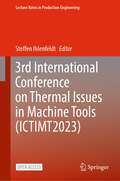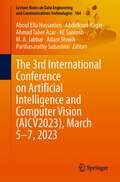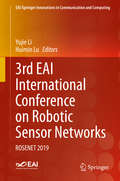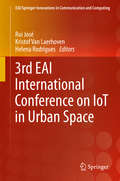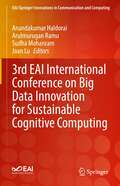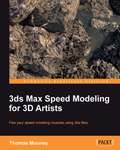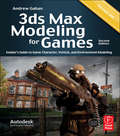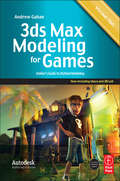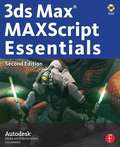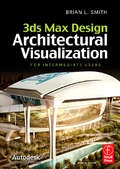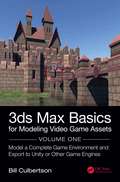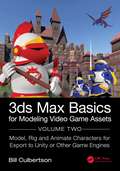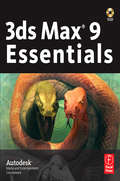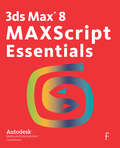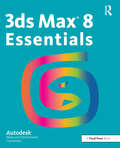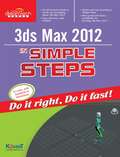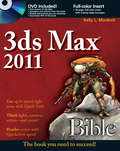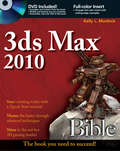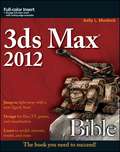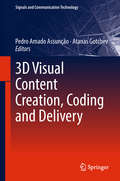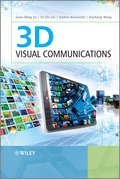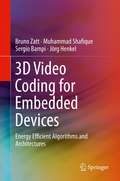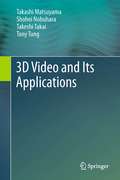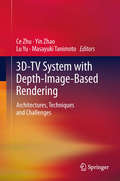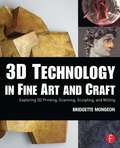- Table View
- List View
3rd International Conference on Thermal Issues in Machine Tools (Lecture Notes in Production Engineering)
by Steffen IhlenfeldtThis open access conference proceedings contains all the papers presented at the ICTIMT 2023, the 3rd International Conference on Thermal Issues in Machine Tools. The event takes place in Dresden, the capital of Saxony, from March 21-23 2023. The conference is organized by the Chair of Machine Tools Development and Adaptive Controls of the Technische Universität Dresden.
The 3rd International Conference on Artificial Intelligence and Computer Vision (Lecture Notes on Data Engineering and Communications Technologies #164)
by Aboul Ella Hassanien Abdelkrim Haqiq Ahmad Taher Azar Kc Santosh M. A. Jabbar Adam Słowik Parthasarathy SubashiniThis book presents the proceedings of the 3rd International Conference on Artificial Intelligence and Computer Vision (AICV’2023) which will be held in Marrakesh, Morocco, during March 05–07, 2023. This international conference, which highlighted essential research and developments in the fields of artificial intelligence and computer visions, was organized by the computer, Networks, Mobility and Modeling Laboratory (IR2M), Faculty of Sciences and Techniques, Hassan First University, Settat, Morocco, the Scientific Research Group in Egypt (SRGE), Cairo University, and the Automated Systems & Soft Computing Lab (ASSCL), Prince Sultan University, Riyadh, Saudi Arabia. The book is divided into sections, covering the following topics: swarm-based optimization mining and data analysis, deep learning and applications, machine learning and applications, image processing and computer vision, sentiment analysis, and recommendation systems, and software-defined network and telecommunication.
3rd EAI International Conference on Robotic Sensor Networks: ROSENET 2019 (EAI/Springer Innovations in Communication and Computing)
by Yujie Li Huimin LuThis proceedings presents the papers of the 3rd EAI International Conference on Robotic Sensor Networks (ROSENET 2019). The conference explores the integration of networks and robotic technologies, which has become a topic of increasing interest for both researchers and developers from academic fields and industries worldwide. The authors posit that big networks will be the main approach to the next generation of robotic research, The book discusses how the explosive number of network models and increasing computational power of computers significantly extends the number of potential applications for robotic technologies while also bringing new challenges to each network's community. The conference provided a platform for researchers to share up-to-date scientific achievements in this field. The conference took place August 17, 2019, Kitakyushu, Japan.Presents the proceedings of the 3rd EAI International Conference on Robotic Sensor Networks (ROSENET 2019), August 17, 2019, Kitakyushu, JapanFeatures papers on robotic technologies for healthcare, medicine, military and moreIncludes perspectives from a multi-disciplinary selection of global researchers, academics, and professionals
3rd EAI International Conference on IoT in Urban Space (EAI/Springer Innovations in Communication and Computing)
by Rui José Kristof Van Laerhoven Helena RodriguesThis proceedings presents the papers from Urb-IoT 2018 - 3rd EAI International Conference on IoT in Urban Space, which took place in Guimarães, Portugal on 21-22 November 2018. The conference aims to explore the emerging dynamics within the scope of the Internet of Things (IoT) and the new science of cities.The papers discuss fusion of heterogeneous urban sources, understanding urban data using machine learning and mining techniques, urban analytics, urban IoT infrastructures, crowd sourcing techniques, incentification and gamification, urban mobility and intelligent transportation systems, real time urban information systems, and more. The proceedings discuss innovative technologies that navigate industry and connectivity sectors in transportation, utility, public safety, healthcare, and education. The authors also discuss the increasing deployments of IoT technologies and the rise of the so-called 'Sensored Cities'‚ which are opening up new avenues of research opportunities towards that future.
3rd EAI International Conference on Big Data Innovation for Sustainable Cognitive Computing (EAI/Springer Innovations in Communication and Computing)
by Anandakumar Haldorai Arulmurugan Ramu Sudha Mohanram Joan LuThis book features the proceedings of The EAI International Conference on Big Data Innovation for Sustainable Cognitive Computing (BDCC 2020), which took place 18 – 19 December 2020. The papers feature detail on cognitive computing and its self-learning systems that use data mining, pattern recognition and natural language processing (NLP) to mirror the way the human brain works. This international conference focuses on technologies from knowledge representation techniques and natural language processing algorithms to dynamic learning approaches. Topics covered include Data Science for Cognitive Analysis, Real-Time Ubiquitous Data Science, Platform for Privacy Preserving Data Science, and Internet-Based Cognitive Platform.
3ds Max Speed Modeling for Games
by Thomas MooneyStep by step illustrated tutorials are supported by a focused commentary. The examples are designed to proceed from starting to model through model finishing to putting models to work within projects and presentation. The book shows both - the entire flow of asset creation and granular methodology. This book will appeal to anyone interested in 3D modeling who wants to improve their speed modeling ability, particularly artists whose work is relevant to industries where hard surface modeling or model prototyping is required, such as games, films, or visualization.
3ds Max Modeling for Games: Insider's Guide to Game Character, Vehicle, and Environment Modeling
by Andrew GahanWith 18 years under his belt in the game industry, a key contributor to the MotorStorm series, and the creator of the 3ds Max in Minutes video series (at FocalPress.com), Andrew Gahan delivers the expert techniques in 3ds Max Modeling for Games, 2nd edition. This updated edition is packed with new tutorials that will enhance your modeling skills and pump up your portfolio with high-quality work in no time. Along with Anthony O'Donnell and a team of experts, Gahan covers all of the fundamental game modeling techniques, including character and environment modeling, mapping, and texturing. Finally, a bonus section in 3ds Max Modeling for Games offers readers insights and tips on how to get their careers started in the game industry. New, expanded tutorials take readers of all abilities through full character and environment modeling from beginning to end Companion website (3d-for-games.com) offers a robust, supportive forum where readers can get commentary on new work, develop skills and portfolio art, as well as network with other game artists on a variety of projects. Also features project files for all tutorials in the book and enough support images and photos to keep the budding artist busy for months Completely updated gallery allows the reader to build on various models
3ds Max Modeling for Games: Insider's Guide to Stylized Game Character, Vehicle and Environment Modeling
by Andrew GahanThere's a new trend towards sylized, comic-style art, with the latest wave of 3D movies (a la Pixar ). Max users can do this kind of thing, and they want to learn how. Andy Gahan is building on the success of his Focal book, 3ds Max Modeling for Games (which covers realistic style art) with this new VOLUME II, covering stylized comic-style art. Forum members are asking for this treatment, and we are delivering. We are linking up to original book branding and titling, and offering the same robust portal for both books - the art on the cover will show the distinction of this volume. The book will offer new modeling techniques, specifically cartoon style - think Pixar, offering new challenges to people who bought Volume I (which focused on more realistic art). Website (www.3d-for-games.com) is unique - an online forum where readers can post and answer questions about their work. In terms of developing a portfolio, online peer critiques are invaluable, and current readers have made use of this feature, in fact some have happily become the forum responders (along with Andy) to coach and develop new artists at work. Also included: step-by-step project files for each chapter; all the relevant texture files and source photos; panoramic skies, small scene objects, bonus texture maps & models so that artists can create whole scenes very quickly without starting from scratch each time; countless examples of what's hot and what's not in 3D modeling and also enough support images and photos to keep the budding artist busy for months. Unrivalled support in over 10,000 current posts - backing up the book with a lively forum and community of readers from all over the world, ready to help your work.
3ds Max MAXScript Essentials
by AutodeskWrite your own MAXScript functions and utilities to automate repetitive tasks and create custom tools and UI elements. Beginning with an introduction to essential programming concepts, you learn the MAXScript basics that include cloning objects, MAX commands, toolbar access, picking scene nodes, picking points, and using the mousetrack command and painter interface. Real-world tutorial examples are provided throughout the book to demonstrate how to use the MAXScript techniques in your own production environment.
3ds Max Design Architectural Visualization: For Intermediate Users
by Brian L. SmithLearn time-saving techniques and tested production-ready tips for maximum speed and efficiency in creating professional-level architectural visualizations in 3ds Max. Move from intermediate to an advanced level with specific and comprehensive instruction with this collaboration from nine different authors from around the world. Get their experience and skills in this full-color book, which not only teaches more advanced features, but also demonstrates the practical applications of those features to get readers ready for a real production environment. Fully updated for the most recent version of 3ds Max.
3ds Max Basics for Modeling Video Game Assets: Model a Complete Game Environment and Export to Unity or Other Game Engines
by William CulbertsonA textbook for learning 3d modeling fundamentals, this step-by-step lesson book develops the readers modeling skills through a series of modeling exercises creating modules for a medieval castle environment. As the text introduces new modeling skills it additionally calls on the reader to perform repetitive tasks, reinforcing skills learned in the process. The content is presented as if the reader is in a working video game studio, being responsible for researching asset design, providing the team with placeholder assets, and final model assets that are unwrapped and custom textured. Upon completion of the modeling projects, the modeled environment is exported to the Unity game engine for use in a real game environment, Although the text uses Autodesk 3ds Max for the modeling program, the principals are transferable to other major modeling programs. Key Features: The goal of this book is to teach the fundamentals of 3d modeling video game assets in a simplified, logical progression, optimized for learning at a beginner level. This series of modeling exercises is the result of having taught over one thousand video game students the fundamentals of 3d modeling. Often, teachers are not fully trained in teaching the concepts of 3d modeling. This text, written for self-paced learning helps those instructors. Includes instructions and project files for exporting the finished project environment into a 3d game engine, Unity. Appendices include additional 3ds Max tool instructions. A companion site includes working 3ds Max project files for Chapters, a 3ds Max user interface and 3ds Max short cut keys and more.
3ds Max Basics for Modeling Video Game Assets: Volume 2: Model, Rig and Animate Characters for Export to Unity or Other Game Engines
by William CulbertsonAs a textbook for learning the fundamentals of modeling, rigging and animating 3D-modeled characters for use in video games, this step-by-step lesson book builds on the reader's modeling skills acquired from reading Volume I. The reader will model characters for the Castle Environment created in Volume I, which will be rigged using the Character Animation Toolkit (CAT) in 3ds Max and animated with game moves. The Skin Modifier is used for associating the meshes to the rigs and the characters are then exported to the Unity game engine and integrated into the Castle Scene with a Third Person Character camera. As the text introduces new modeling skills, it additionally calls on the reader to perform repetitive tasks, reinforcing skills learned in the process. The content is presented as if the reader is in a working video game studio, being responsible for researching asset design and providing the team with placeholder assets and final model assets that are unwrapped and custom textured using both box mapping and the 3ds Max Quick Peel tool. Although the text uses Autodesk 3ds Max for the modeling program, the principles are transferable to other major modeling programs. Key Features: The goal of this book is to teach the fundamentals of 3D modeling video game characters in a simplified, logical progression optimized for learning at a beginner level. Rigging principles (Linking, Inverse Kinematics [IK], Forward Kinematics [FK], Skin Deformation, Weighting Vertices and more) are introduced in a gradual progression to allow maximum comprehension and retention. This series of modeling exercises is the result of having successfully taught over 1000 video game students the fundamentals of 3D modeling. This complete, clearly written and concise text is written for self-paced learning, helping those instructors who might not be fully trained in 3D modeling and those interested in self-teaching. Includes instructions and project files for exporting the finished project environment into the 3D game engine, Unity. A companion site (www.3dsMaxBasics.com) includes working 3ds Max project files for chapters, notes and corrections, a 3ds Max user interface, 3ds Max shortcut keys and more.
3ds Max 9 Essentials: Autodesk Media and Entertainment Courseware
by AutodeskBring 3D film effects to the big screen. Generate realistic characters for a top-selling game. Create rich and complex design visualization. Autodesk® 3ds Max® 9 lets you maximize your productivity and tackle challenging animation projects. And this book, developed by Autodesk insiders, lets you master the essential tools and techniques. Learn how to use 3ds Max 9 confidently in a production environment. Each chapter of this book has a series of theory lessons and one lab. The theory lessons introduce you to the functional areas of 3ds Max and explain these features with short simple examples. The lab demonstrates a practical application of the theory. Combined, each chapter delivers a sound understanding of the functions, features and principles behind 3ds Max 9, and shows you how to apply this knowledge to real-world situations.
3ds Max 8 MAXScript Essentials
by AutodeskWrite your own MAXScript functions and utilities to create custom tools and UI elements, and automate repetitive tasks. Demonstrated techniques include the creation of objects, arrays, collections, control structures, parametric objects, and the construction of UI elements. The companion CD-ROM contains media files that allow you to practice the techniques with real-world examples demonstrating how you can use then in a production environment.
3ds Max 8 Essentials: Autodesk Media and Entertainment Courseware (Autodesk Media And Entertainment Courseware Ser.)
by AutodeskWelcome to the Autodesk Media and Entertainment Official Training Courseware for 3ds Max 8 software! Consider this book an all-access pass to the production and training experience of Autodesk developers and training experts. Written for self-paced learning or instructor-led classroom training, the manual will teach you the fundamentals of using 3ds Max 8. The book is organized into sections dedicated to animation, modelling, materials, lighting and rendering. Each section covers basic theory, and then includes exercises for hands-on demonstration of the concept. By the end of the book, you will have mastered the basics and moved onto full-length projects. Flexibility is built in, so that you can complete the tutorials in the way that works best for you. Complete the book and you will be a seasoned 3ds Max pro, ready to work confidently in a production environment.
3ds Max 2012 In Simple Steps
by Kogent Learning Solutions Inc3Ds Max 2012 In Simple Steps Author: Kogent Learning Solutions Inc.
3ds Max 2011 Bible (Bible #719)
by Kelly L. MurdockUpdated version of the bestselling 3ds Max book on the market Used by more than 150,000 people, and the winner of more than 65 industry awards, 3ds Max is the world's most popular animation modeling and rendering software for film, television, video games, and design visualization. 3ds Max Bible is the world’s most popular book for getting the most out of the software. Whether a novice looking to create something immediately using the Quick Start tutorial, or an experienced 3ds Max user who simply wants to check out the software's latest and greatest features, this update to the bestselling 3ds Max book on the market continues to be the most comprehensive reference on this highly complex application. Packed with expert advice, timesaving tips, and more than 150 step-by-step tutorials 16-page color insert highlights the work of some of today’s most cutting-edge 3D artists Includes a companion DVD with a searchable, full-color version of the 3ds Max Bible, as well as customizable models and textures The only comprehensive reference-tutorial on 3ds Max, it's no wonder the 3ds Max Bible is the bestselling 3ds Max book in the world and a favorite of both amateur and professional animators. Note: CD-ROM/DVD and other supplementary materials are not included as part of eBook file.
3ds Max 2010 Bible (Bible #590)
by Kelly L. MurdockThe bestselling 3ds Max book ever, now updated for the latest version 3ds Max is the world's most popular animation modeling and rendering software used to create 80 percent of commercially available video games, including those for Microsoft's Xbox 360, Sony's Playstation 3, and Nintendo's Wii. It is an expensive, intricate program that can take years to thoroughly master. As the ultimate comprehensive reference and tutorial on 3ds Max, this guide contains in-depth coverage of every aspect of 3ds Max and explores the newest features that the latest version has to offer. You'll learn to master the complexities of 3ds Max under the guidance of 3D expert Kelly Murdock. Includes in-depth detail on all the latest features for veterans of earlier versions of 3ds Max from 3D expert Kelly Murdock Shares expert advice, timesaving techniques, and more than 150 step-by-step tutorials Features a 16-page, full-color insert with inspiring examples of cutting-edge 3ds Max art Bonus DVD contains all the examples from the book, unique models and textures that you can customize on your own, and a searchable, full-color version of the book A Quick Start chapter shows you how to create an exciting animation on your very first day with the software so you can dive in and get started immediately. Note: CD-ROM/DVD and other supplementary materials are not included as part of eBook file.
3ds Max 2010 Bible
by Kelly L. MurdockThe bestselling 3ds Max book ever, now updated for the latest version3ds Max is the world's most popular animation modeling and rendering software used to create 80 percent of commercially available video games, including those for Microsoft's Xbox 360, Sony's Playstation 3, and Nintendo's Wii. It is an expensive, intricate program that can take years to thoroughly master.As the ultimate comprehensive reference and tutorial on 3ds Max, this guide contains in-depth coverage of every aspect of 3ds Max and explores the newest features that the latest version has to offer. You'll learn to master the complexities of 3ds Max under the guidance of 3D expert Kelly Murdock.Includes in-depth detail on all the latest features for veterans of earlier versions of 3ds Max from 3D expert Kelly MurdockShares expert advice, timesaving techniques, and more than 150 step-by-step tutorialsFeatures a 16-page, full-color insert with inspiring examples of cutting-edge 3ds Max artBonus DVD contains all the examples from the book, unique models and textures that you can customize on your own, and a searchable, full-color version of the bookA Quick Start chapter shows you how to create an exciting animation on your very first day with the software so you can dive in and get started immediately.Note: CD-ROM/DVD and other supplementary materials are not included as part of eBook file.
3D Visual Content Creation, Coding and Delivery (Signals and Communication Technology)
by Pedro Amado Assunção Atanas GotchevThis book covers the different aspects of modern 3D multimedia technologies by addressing several elements of 3D visual communications systems, using diverse content formats, such as stereo video, video-plus-depth and multiview, and coding schemes for delivery over networks. It also presents the latest advances and research results in regards to objective and subjective quality evaluation of 3D visual content, extending the human factors affecting the perception of quality to emotional states. The contributors describe technological developments in 3D visual communications, with particular emphasis on state-of-the-art advances in acquisition of 3D visual scenes and emerging 3D visual representation formats, such as: multi-view plus depth and light field;evolution to freeview and light-field representation;compression methods and robust delivery systems; andcoding and delivery over various channels. Simulation tools, testbeds and datasets that are useful for advanced research and experimental studies in the field of 3D multimedia delivery services and applications are covered. The international group of contributors also explore the research problems and challenges in the field of immersive visual communications, in order to identify research directions with substantial economic and social impact. 3D Visual Content Creation, Coding and Delivery provides valuable information to engineers and computer scientists developing novel products and services with emerging 3D multimedia technologies, by discussing the advantages and current limitations that need to be addressed in order to develop their products further. It will also be of interest to students and researchers in the field of multimedia services and applications, who are particularly interested in advances bringing significant potential impact on future technological developments.
3D Visual Communications
by Yu-Chi Lai Haohong Wang Guan-Ming Su Andres KwasinskiProvides coverage of the major theories and technologies involved in the lifecycle of 3D video content deliveryPresenting the technologies used in end-to-end 3D video communication systems, this reference covers 3D graphics and video coding, content creation and display, and communications and networking. It covers the full range of key areas from the fundamentals of 3D visual representation to the latest 3D video coding techniques, relevant communication infrastructure and networks to the 3D quality of experience.The book is structured to logically lead readers through the topic, starting with generic and fundamental information, continuing with a detailed section of different visualisation techniques before concluding with an extensive view of 3D mobile communication systems and trends. The authors give most focus to four important areas: 3D video coding and communications; 3D graphics/gaming and mobile communications; end-to-end 3D ecosystem (including 3D display, 3D player, networking facility and 3D quality issues), and future communications and networks advances for emerging 3D experience.Presents the theory and key concepts behind the latest 3D visual coding framework, standards, and corresponding quality assessmentProvides fundamental material which forms the basis for future research on enhancing the performance of 3D visual communications over current and future wireless networksCovers important topics including: 3D video coding and communications; 3D graphics/gaming and mobile communications; end-to-end 3D ecosystem; and future communications and networks advances for emerging 3D experienceEssential reading for engineers involved in the research, design and development of 3D visual coding and 3D visual transmission systems and technologies, as well as academic and industrial researchers.
3D Video Coding for Embedded Devices: Energy Efficient Algorithms and Architectures
by Jörg Henkel Muhammad Shafique Sergio Bampi Bruno ZattThis book shows readers how to develop energy-efficient algorithms and hardware architectures to enable high-definition 3D video coding on resource-constrained embedded devices. Users of the Multiview Video Coding (MVC) standard face the challenge of exploiting its 3D video-specific coding tools for increasing compression efficiency at the cost of increasing computational complexity and, consequently, the energy consumption. This book enables readers to reduce the multiview video coding energy consumption through jointly considering the algorithmic and architectural levels. Coverage includes an introduction to 3D videos and an extensive discussion of the current state-of-the-art of 3D video coding, as well as energy-efficient algorithms for 3D video coding and energy-efficient hardware architecture for 3D video coding.
3D Video and Its Applications
by Shohei Nobuhara Tony Tung Takashi Matsuyama Takeshi TakaiThis book presents a broad review of state-of-the-art 3D video production technologies and applications. The text opens with a concise introduction to the field, before examining the design and calibration methods for multi-view camera systems, including practical implementation technologies. A range of algorithms are then described for producing 3D video from video data. A selection of 3D video applications are also demonstrated. Features: describes real-time synchronized multi-view video capture, and object tracking with a group of active cameras; discusses geometric and photometric camera calibration, and 3D video studio design with active cameras; examines 3D shape and motion reconstruction, texture mapping and image rendering, and lighting environment estimation; demonstrates attractive 3D visualization, visual contents analysis and editing, 3D body action analysis, and data compression; highlights the remaining challenges and the exciting avenues for future research in 3D video technology.
3D-TV System with Depth-Image-Based Rendering: Architectures, Techniques and Challenges
by Masayuki Tanimoto Ce Zhu Lu Yu Yin ZhaoRiding on the success of 3D cinema blockbusters and advances in stereoscopic display technology, 3D video applications have gathered momentum in recent years. 3D-TV System with Depth-Image-Based Rendering: Architectures, Techniques and Challenges surveys depth-image-based 3D-TV systems, which are expected to be put into applications in the near future. Depth-image-based rendering (DIBR) significantly enhances the 3D visual experience compared to stereoscopic systems currently in use. DIBR techniques make it possible to generate additional viewpoints using 3D warping techniques to adjust the perceived depth of stereoscopic videos and provide for auto-stereoscopic displays that do not require glasses for viewing the 3D image. The material includes a technical review and literature survey of components and complete systems, solutions for technical issues, and implementation of prototypes. The book is organized into four sections: System Overview, Content Generation, Data Compression and Transmission, and 3D Visualization and Quality Assessment. This book will benefit researchers, developers, engineers, and innovators, as well as advanced undergraduate and graduate students working in relevant areas.
3D Technology in Fine Art and Craft: Exploring 3D Printing, Scanning, Sculpting and Milling
by Bridgette MongeonThe possibilities for creation are endless with 3D printing, sculpting, scanning, and milling, and new opportunities are popping up faster than artists can keep up with them. 3D Technology in Fine Art and Craft takes the mystery out of these exciting new processes by demonstrating how to navigate their digital components and showing their real world applications. Artists will learn to incorporate these new technologies into their studio work and see their creations come to life in a physical form never before possible. Featuring a primer on 3D basics for beginners,interviews, tutorials, and artwork from over 80 artists, intellectual property rights information, and a comprehensive companion website, this book is your field guide to exploring the exhilarating new world of 3D. Follow step-by-step photos and tutorials outlining the techniques, methodologies, and finished products of master artists who have employed 3D technology in new and inventive ways Learn how to enlarge, reduce, and repurpose existing artwork and create virtual pieces in physical forms through a variety of mediums Research your options with an accessible list of pros and cons of the various software, 3D printers, scanners, milling machines, and vendors that provide services in 3D technology Listen to podcasts with the artists and learn more tips and tricks through the book's website at www.digitalsculpting.net
